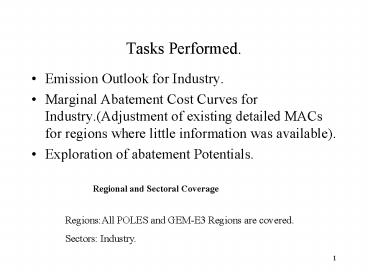Emission Outlook for Industry' - PowerPoint PPT Presentation
1 / 20
Title:
Emission Outlook for Industry'
Description:
... in the production of nylon - nitric acid is a major component of adipic acid. ... demand 3)Aggreement of the major adipic acid producers to a voluntary reduction ... – PowerPoint PPT presentation
Number of Views:36
Avg rating:3.0/5.0
Title: Emission Outlook for Industry'
1
Tasks Performed.
- Emission Outlook for Industry.
- Marginal Abatement Cost Curves for
Industry.(Adjustment of existing detailed MACs
for regions where little information was
available). - Exploration of abatement Potentials.
Regional and Sectoral Coverage
RegionsAll POLES and GEM-E3 Regions are
covered. Sectors Industry.
2
GHG from Industry (non-energy related).
Total2453 mt CO eq
Total1296 mt CO eq
Total3891 mt CO eq
3
Emission Outlook
HFC Sources HFC 134a is used as a refrigerant in
motor vehicle air conditioners also HFCs are used
in in foams and aerosols and from 1994 these
compounds also found applications as solvents.
HFC-23 is generated as a byproduct during the
production of (HCFC-22). Outlook Assumptions The
hfc emissions as ods substitutes increased
dramatically due to efforts to phase out cfc and
other ods. Nearly all producers in developed
countries have implemented process optimization
or thermal destruction to reduce HFC-23
emissions. Emissions are expected to continue
decreasing because HCFC-22 production, is
scheduled to be phased-out by 2030.
4
Emission Outlook.
- N2O Sources
- Nitrous Oxide is emitted during the production of
both adipic and nitric acid (adipic acid is
mainly used in the production of nylon - nitric
acid is a major component of adipic acid. - Outlook Assumptions
- 1)Shifts in chemical production to developing
countries. - 2)Decrease in nitric acid demand 3)Aggreement of
the major adipic acid producers to a voluntary
reduction of their emissions by the end of 2000.
5
Emission Outlook.
PFC Sources Semiconductor manufacturing.(mainly
from the US, EU-15, and Japan),Solvents,Aerosols.
Outlook Assumptions Market demand for
semiconductors is projected to continue its
current rapid growth until 2010. Correspondingly,
a rapid growth in PFC emissions from the
semiconductor industry is projected for this
period. In April 1999, the World Semiconductor
Council (WSC) agreed to reduce PFC emissions.
6
Emission Outlook.
- PFC Sources
- Aluminium production is the largest source of
PFCs (the magnitude of the emissions depends on
the frequency of the anode effects). - Outlook Assumptions
- Reductions in domestic aluminium production and
actions taken to reduce the frequency and
duration of anode effects (Voluntary Aluminium
Industrial Partership.). The production growth
results from additions to current aluminum
capacity, mostly in the developing world, and
improvements in cell technology that increase
production efficiency at existing smelters
worldwide. Emission rates, on the other hand, are
expected to decrease as upgrades in process
controls and alumina feeding systems will yield
shorter, less frequent anode effects. The
developed countries as a whole will see a
substantial decrease in emissions because of the
combined effect of production moving to
developing countries and reduced emission rates.
7
Emission Outlook.
- Emissions Sources
- Cement manufacture results in the generation of
carbon dioxide.The largest source of industrial
co2 (non energy related) emissions is the cement
production. - Outlook Assumptions
- Anticipated Increase in Cement Production.
8
Emission Outlook.
- Emissions Sources
- The magnesium metal production and casting
industry uses sulfur hexafluoride (SF6) as a
cover gas to prevent the violent oxidation of
molten magnesium in the presence of air.The
industry adopted the use of SF6 to replace sulfur
dioxide (SO2). SF6 is also emitted during the
production of aluminium. - Outlook Assumptions
- Voluntary SF6 Emission Reduction Partnership for
the Magnesium Industry. Shift of aluminium
production in the developing world,
9
Absolute Increase in Mt of CO2 eq. from 1995 to
2030.Total 2595 CO2 eq.
10
Abatement Technologies.
- N20 from Chemical Industry
- 1) Process Integrated measures that require new
plants. - 2) End of pipe measures Emissions can be
reduced through end of pipe equipment based on
catalytic conversion . - HFC from Other Industries
- 1) Process Optimization Process optimization
and modifying production equipment can both
optimize HCFC-22 production and reduce HFC-23
emissions. Process optimization is relatively
inexpensive and is likely to be most effective in
reducing the emissions from plants that are
generating HFC-23 at a rate of 3 to 4. - 2) Thermal Oxidation It has been estimated that
the total installed capital costs for a thermal
oxidation system are approximately 7 million per
plant with total annual operational costs of
200,000 per year (Honeywell, 2000) (30
reduction). - CO2 from non metallic minerals
- 1) Blended cements', using such ingredients as
coal fly ash, where the CO2 emissions are
slightly suppressed, by a maximum of 10-15.
There is no known technology to reduce carbon
dioxide emissions of Portland cement any further.
11
Abatement Technologies
- SF6 from Other Industry
- 1) Capture/Recycle SF6 Air Liquide developed
an SF6 capture/recycle system that could reduce
SF6 emissions by up to 95 percent from current
levels (Li, 2000). The captured SF6 can be
re-used by the industry onsite. - PFC from Other Industry
- 1) PFC Capture/Recovery. Currently available
capture systems are guaranteed to remove 90
percent of emissions. - PFC from non ferrous metals
- 1) Improving Alumina Feeding Techniques.
- Using Improved Computer Controls to optimize cell
performance (30 reduction). - Training Cell Operators on methods and practices
to minimize the frequency and duration of AEs.
12
MACC China
13
MACC Former Soviet Union
Catalytic Conversion
14
MACC Japan
Capture and Destruct
Recycling
15
(No Transcript)
16
Abatement Scenario
The Carbon Values used in the Scenario resulted
from an exercise carried out using POLES to
simulate a version of the Soft-landing Scenario
17
Abatement Potential
18
Abatement Potential
19
(No Transcript)
20
Abatement Potential































